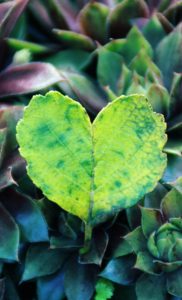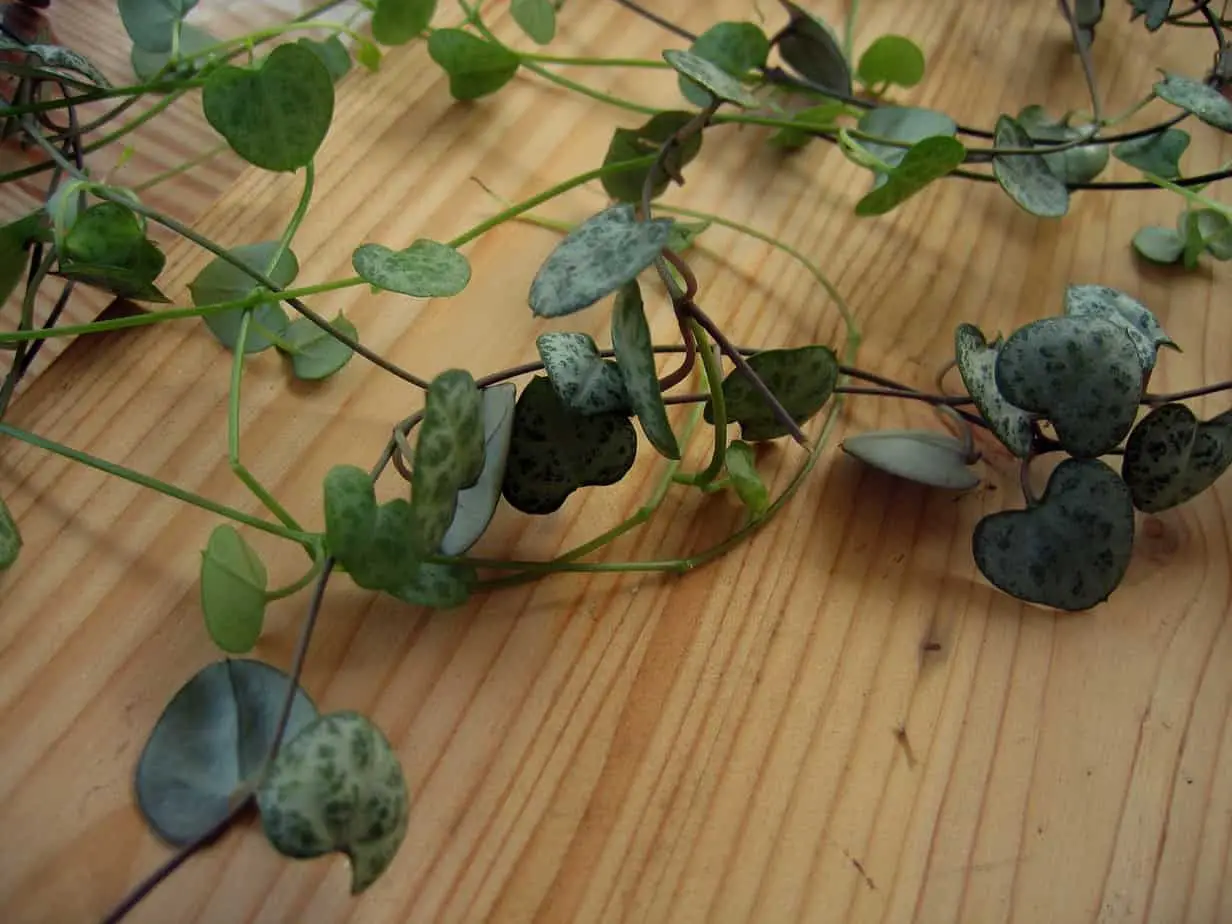Some links in the post are affiliate links and I get a commission from purchases made through some links found in the post.
If you are thinking of upping your home’s aesthetic appeal, you might want to try the string of hearts.
This plant, scientifically known as Ceropegia woodii, is a unique trailing plant with succulent features.
It works great for hanging baskets owing to its long trailing branches that face down with leaves growing in large bead forms. Some are even more striking with their variegated leaves.
It is native to the southern part of Africa; hence the need to tweak its growing conditions to match the same.
It goes by other names such as chain of hearts, collar of hearts, string of hearts, rosary vine, hearts-on-a-string, and sweetheart vine.
While this plant is fairly easy to grow, its leaves can turn yellow over time. Today, we focus on what can cause this change and quick remedies for the same:
Why your String of Hearts Leaves could be Turning Yellow
The main reason your string of hearts leaves could be turning yellow is due to being overwatered. This will cause the soil to become soggy causing the leaves to drop off and turn yellow.
Other reasons your string of hearts leaves can be turning yellow is due to the wrong temperatures.
For a trailing plant, the last thing you want is for the plant to appear sickly, thus taking away from the appeal of a hanging basket.
If your plant’s leaves suddenly appear yellow, below are some likely causes:
Low Temperatures
The string of hearts is native to South Africa and thus requires similar growing conditions. Ideally, conditions in your home or outdoors should range between 18 and 24°C.
That is easy to achieve in most homes. The plant can make do with temperatures that are slightly off this range.
However, the colder it becomes, the easier it becomes for the plant to start yellowing. The plant will generally do well in warmer conditions.
Thus, the temperatures should be above the 18-24°C range than for them to go lower. The least allowable temperature is 16°C.
Overwatering
Let us start with this – the string of hearts is a succulent plant. What does this mean? It means that it has adaptations suited to storing water.
The plant prefers to be dry, and you should thus wait for the soil to be parched before watering it again.
When watering, you should be thorough but should not wet the soil. Instead, you should dampen it.
Note that too much water washes out the soil’s nutrients, leading to iron deficiency in the plant.
Also, please watch the frequency of the watering. Ideally, you should water the plant every three weeks.
However, your climatic conditions could lead to the soil drying out way before or after this mark.
As such, always check the state of the soil before adding any water to it. During winter, the plant goes dormant and will not use as much water, thus calling for less watering.
How to Save a Yellow String of Hearts
So, your plant has yellowed. Can you do anything about it? Luckily, yes! Please proceed as follows:
Temperature
Your plant is sensitive to temperature variations and will start yellowing if the temperatures get too cold.
Check the temperature of the environment in which the plant is growing using a thermometer. If it falls below 16°C, move the plant to a warmer location or increase the heating.
The beauty of hanging baskets is that you can move them as needed. If a week goes by and no change is evident, you might want to consider other causes of yellowing.
Additionally, you might want to propagate the healthy parts, as the yellowing may also indicate that the plant has suffered extensive damage.
Overwatering
 With yellowing, damage to the roots is unlikely to be present. But when you water the plant more than is necessary, root damage can occur.
With yellowing, damage to the roots is unlikely to be present. But when you water the plant more than is necessary, root damage can occur.
Overwatering your string of hearts presents as yellow leaves, falling off of leaves, and root rot. If you do not address the change fast, the plant can eventually die.
The mode of saving depends on the extent of the damage. With slight damage to the roots, you can repot the plant.
But with extensive root rot, you may need to propagate your plant, as we will later cover.
Repotting
This process is quite simple.
First, you need to move your plant away from direct sunlight to give it time to recover.
A mistake people often make is to assume that they should have the plant in the open to allow the soil to dry.
Unfortunately, this only strains the already weakened plant, prompting it to wilt and die.
Next, you need to gently remove the plant from its original pot, ensuring that you start by loosening the soil around the roots.
Do not tug at the already weakened roots. Instead, work on the soil from the top to the root section and remove the whole plant.
You can now section off the dead roots and vines, cut these, and put them in a compost heap.
Please do not cut off any white bulbs on the roots unless they appear diseased. These aid in the growth of new vines.
You can now leave the roots to dry out in the open, away from direct sunlight. Do this for a few hours until the plant appears less saturated.
As you wait, pour out the soil in the original pot and disinfect the container as preferred.
Failure to disinfect means that any microbial growth present in the previous soil will affect the newly propagated plant.
Using a new soil mix is advisable. Also, check the pot to ensure that there are enough drainage holes, which might be the reason for the waterlogging.
Add some more holes to ensure proper drainage before adding the soil mix to ¾ level of the pot.
When the roots are dry, add them to the soil mix and cover them with soil, leaving an inch at the top.
Dampen the soil and leave the plant in a warm place away from direct sunlight.
Can you Save it by Propagating a Healthier Part?
As earlier mentioned, the roots’ damage may be so great that you might need to propagate the plant.
That points to growing a new plant from the old one’s vines and tubers. Here’s how to do it:
By Soil
The first method involves soil propagation.
Start by creating an airy soil mix in a container. Next, cut off healthy vines with nodes from the affected plant and place these in the soil, ensuring the leaves are above the soil.
Dampen the mix and place the container away from direct sunlight. You should see growth in about 4 weeks and can move the vine to another pot for maturity.
You can now care for the plant as needed.
If you cannot find healthy vines, you can work with the bead-like tubers. These appear as white beads on the vines.
Cut off these tubers and place them on soil, as you would with the vines.
Dampen the soil and wait about 4 weeks, after which the tubers should produce roots. You can now cut off the vines and plant them as instructed earlier.
By Water
While the string of hearts is a succulent, you can propagate it using water. Take healthy vines from the plant and get rid of the leaves.
Find a glass container and fill it with water before covering it with clear plastic. On the plastic, tear some holes in which you can place the vines.
Place the container in indirect sunlight and allow the vines 4 weeks for them to start rooting. You can now move the roots to another pot and care for them as needed.
You may be interested in: How to save your overwatered string of hearts
Caring for your String of Hearts
We have mentioned caring for your plant as needed, but what does this mean?
Here is how you can prevent string of hearts turning yellow as well as other common problems that can affect your plant:
Soil
The soil should be damp but not wet and should be well-draining.
To increase the draining capabilities, have some small pebbles in the soil. For best results, you should work with a succulent mix.
Light
 Please note that lighting and sunlight are not the same. As much as your plant will do well in bright light, it does not thrive in direct sunlight.
Please note that lighting and sunlight are not the same. As much as your plant will do well in bright light, it does not thrive in direct sunlight.
Thus, aim at reducing sunlight exposure while ensuring that your plant gets enough light. For example, in the outdoors, your plant should be in bright shade.
It sounds like a conundrum, but this is the ideal growing condition for your string of hearts. For indoor growing, work with south and west-facing windows.
Watering
We covered the frequency and amount of water your plant needs under the causes of yellowing.
Keep in mind that your plant is a succulent, and watering should be on the minimum.
Temperature
Remember when we stated that the ideal temperature range is 18-24°C?
That is pretty much all you need to know about varying the growing conditions. Anything below 16°C can cause yellowing and even death of the plant.
Humidity
Humidity levels should be at 40-50%, similar to the range in most indoor conditions. In some cases, you might need a humidifier to achieve this range.
Fertilization
Your plant does not need much enrichment. If you can fertilize it once in summer and again in spring using half-strength fertilizer, it should be fine.
Avoid using fertilizer in winter when the plant is dormant.
Common String of Hearts Problems
Drooping Leaves
Yellowing of leaves followed by falling off is a sign of overwatering. It would be best if you reduce your watering frequency and amounts immediately.
Curling Leaves
As much as this plant is a succulent, you can end up under-watering it. If the plant does not get water for long, the water reservoirs in the tubers can run dry and cause leaf curling.
Try and water your plant every 3 or so weeks for indoor conditions.
Mold
If you notice a white substance on the surface of the soil, mold might be present. You can deal with this by moving the plant to a warmer place and checking the soil drainage.
Final Thoughts: Why is my String of Hearts Leaves Turning Yellow?
Yes, with a string of hearts, your best bet lies in moderating between two mantras. You can use ‘less is more’ in this case.
Use less water, less fertilizer, less sunlight exposure, and your plant will be fine. But when it comes to drainage and temperature, go with ‘go big or go home!’ Happy gardening!
Before you go, here are some more related articles I encourage you to read below to help solve more of your gardening issues:

